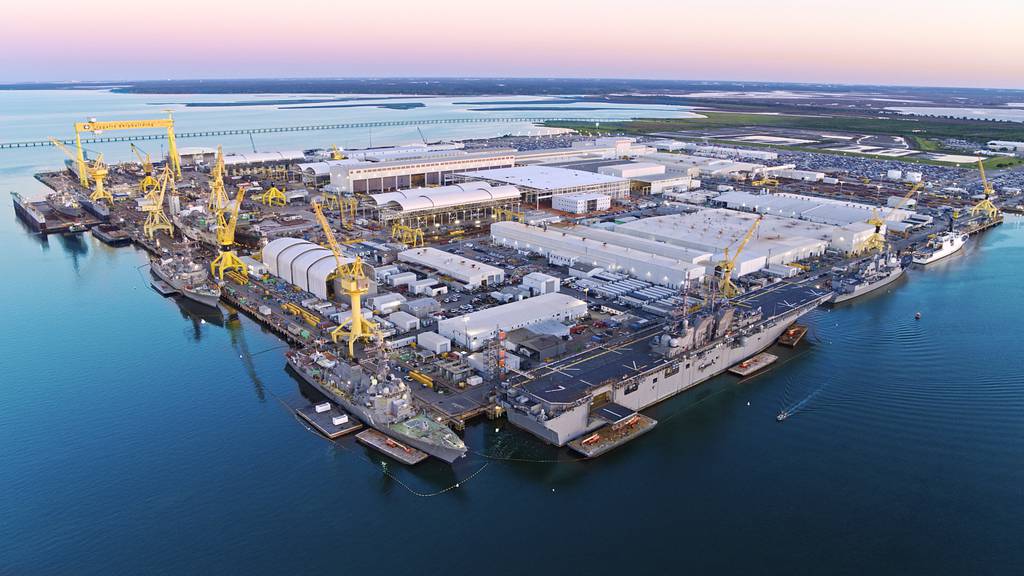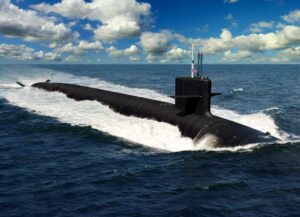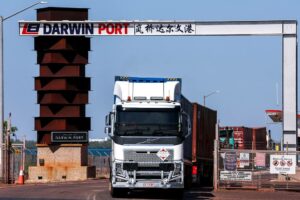
This story was updated April 25, 2023, at 7:53 p.m. EST with a statement from an Ingalls Shipbuilding spokesperson.
WASHINGTON — A small houseboat floats on Bayou Lafourche in rural Louisiana, housing workers at the family-owned Bollinger Shipyards’ Lockport facility situated roughly 35 miles upstream from the Gulf of Mexico.
It’s one of the temporary living facilities that Bollinger maintains to house non-local workers and spare them lengthy commute times — one of the incentives the small shipyard offers to lure and retain employees from a limited pool of skilled shipbuilding labor in the region. Across the street, several workers in half-a-dozen fabrication plants are busy welding steel while electricians wade through a tangle of wires in assembled modules for the Coast Guard’s Fast Response Cutters.
Bollinger employs about 3,500 people at 14 facilities scattered throughout Louisiana and Mississippi, and CEO Ben Bordelon predicts that he will likely have to hire between 500 to 1,000 additional workers within the next two years, excluding subcontractors.
“Engineers right now are tough [to find], and designers,” Bordelon told Defense News in an April interview at the Lockport facility. “I hate to say just the basic stuff, but shipbuilders, welders, electricians, painters; we have a need right now for a lot of different crafts.”
The workforce shortages Bollinger faces are not unique. Shipyards across the country point to labor shortfalls as one of the biggest constraints hampering U.S. shipbuilding capacity, as the Navy scrambles to reach its statutorily required 355-ship fleet. A November analysis from the Congressional Budget Office found that the Navy’s plan will average between $30 billion and $33 billion in spending annually over the next 30 years.
Bollinger recently won a contract to build the Navy’s sixth berthing barge, used to temporarily house military personnel, but the competition for labor is particularly acute in the Gulf where the company must compete with two nearby behemoths in the industry as well as a bevy of smaller shipyards on top of the oil and gas industry.
The company frequently moves workers around its multiple facilities as production needs shift. For instance, its newly acquired facility in Pascagoula, Mississippi, requires an influx of labor to build the Coast Guard’s next Polar Security cutter. Pascagoula is also home to Ingalls Shipbuilding, the state’s largest employer with approximately 11,500 employees.
Ingalls, whose Navy contracts include the Arleigh Burke class destroyer and the amphibious San Antonio-class LPD, is also expected to go on a hiring spree.
“Workforce development is hard stuff, however we’re very focused on it and seeing good hiring trends,” Kimberly Aguillard, Ingalls Shipbuilding spokesperson, told Defense News.
Ingalls Shipbuilding President Kari Wilkinson told reporters in April at the annual Sea Air Space conference in Maryland that the company hired “thousands of people in a normal year.”
Forty-five miles away from Ingalls, Austal USA’s shipyard in Mobile, Alabama, employs nearly 3,000 people. Even as it wraps up work on assembling the Navy’s last Littoral Combat Ship, the shipyard seeks to increase the size of its workforce by one-third as it opens a new installation devoted exclusively to constructing submarine modules.
“We’re putting a new building in that’s going to be dedicated fully to submarine work,” Larry Ryder, Austal’s vice president for business development and external affairs, told Defense News in an April interview at the shipyard. “It’s going to be about 1,000 jobs of output, supporting the submarine-industrial base.”
The tight labor market and the new hiring gives workers greater leverage in salary negotiations.
Salary data aggregated by Glassdoor indicates that welders in the three states typically earn anywhere between $27,000 to $58,000 per year, with pay increasing for more specialized skillsets. The salary range for electricians in the area from $30,000 to $77,000 per year.
The companies are getting creative with the perks they offer to draw in workers while also investing in their own apprenticeship programs to build a future workforce pool in the hopes that it will benefit the shipbuilding industry in the region writ large.
For instance, Ingalls opened a Chick-fil-a in the middle of its shipyard to give employees an alternative to the relatively bland cafeteria food. Shortly after it opened, Ingalls had to take the franchise off of Google Maps after fried chicken fans unwittingly drove up to the secure yard in search of the franchise.
Meanwhile, Austal adjusted its shift schedule so its workers work 10 hour days for four days a week. Employees have the option of a three-day weekend or working overtime on Friday. It also runs its own training academy for apprentices, as do its competitors.
“You’ve got to have good safety programs, good benefits, good training – spending money up front on recruiting the right people,” said Bollinger’s Bordelon. “We offer recruiting bonuses internally.”
Ingalls partners with local schools and universities to recruit unskilled apprentices at the Maritime Training Academy at its shipyard. The facility houses multiple rooms, each devoted to a particular component of the craft like handling sheet metal. In one room, some eight trainees in hard hats and goggles practiced pipefitting with an instructor.
The academy allows trainees to begin working at Ingalls while learning hands-on shipbuilding skills, first in the classroom and then on actual modules in the yard as part of a two to three year program. It used to train more than 1,000 students before the height of the COVID pandemic, which lowered that number to 400. Ingalls hopes to increase its number of trainees to 800 by the end of this year and go beyond that next year.
“Ingalls hires on a scale far bigger than us,” said Austal’s Ryder. “Bollinger is hiring. We’re hiring. So, it’s a challenge. And we’ve got to to think beyond just Mobile. We’ve got to to think nationally on how do we draw people to the region.”
Bryant Harris is the Congress reporter for Defense News. He has covered U.S. foreign policy, national security, international affairs and politics in Washington since 2014. He has also written for Foreign Policy, Al-Monitor, Al Jazeera English and IPS News.
- SEO Powered Content & PR Distribution. Get Amplified Today.
- PlatoAiStream. Web3 Data Intelligence. Knowledge Amplified. Access Here.
- Minting the Future w Adryenn Ashley. Access Here.
- Source: https://www.defensenews.com/industry/2023/04/25/gulf-shipyards-struggle-to-find-workers-amid-shipbuilding-spree/
- :has
- :is
- :not
- :where
- ][p
- $UP
- 000
- 1
- 10
- 11
- 12
- 14
- 2014
- 2023
- 500
- 7
- 70
- a
- About
- Academy
- acquired
- across
- Additional
- Adjusted
- Affairs
- After
- AIR
- AL
- Alabama
- allows
- also
- alternative
- Amid
- an
- analysis
- and
- annual
- Annually
- anywhere
- approximately
- April
- ARE
- AREA
- around
- AS
- assembled
- At
- average
- base
- basic
- BE
- before
- begin
- Behemoths
- benefit
- benefits
- between
- Beyond
- bigger
- Biggest
- Billion
- bonuses
- budget
- build
- Building
- business
- business development
- busy
- but
- by
- Capacity
- ceo
- challenge
- class
- Coast
- combat
- Commute
- Companies
- company
- compete
- competition
- competitors
- component
- Conference
- Congress
- Congressional
- constraints
- constructing
- contract
- contracts
- country
- covered
- Covid
- craft
- Creative
- data
- Days
- dedicated
- Defense
- designers
- Development
- different
- do
- each
- earn
- employees
- employs
- end
- English
- Even
- excluding
- exclusively
- expected
- external
- faces
- facilities
- Facility
- fans
- FAST
- Find
- First
- focused
- food
- For
- foreign
- foreign policy
- found
- four
- Franchise
- frequently
- Friday
- Fried Chicken
- from
- front
- fully
- future
- GAS
- getting
- Give
- gives
- Glassdoor
- Go
- going
- good
- google maps
- greater
- had
- Handling
- hands-on
- Hard
- Have
- he
- height
- hire
- hires
- Hiring
- Home
- hopes
- House
- houses
- housing
- How
- However
- HTTPS
- images
- in
- Incentives
- include
- Increase
- increasing
- indicates
- industry
- influx
- installation
- instance
- internally
- International
- Interview
- investing
- IT
- ITS
- Jobs
- jpg
- just
- labor
- labor market
- large
- largest
- Last
- learning
- Leverage
- like
- likely
- Limited
- living
- local
- Lot
- Louisiana
- maintains
- Maps
- Maritime
- Market
- Maryland
- metal
- Mexico
- Middle
- Military
- Mississippi
- Mobile
- Modules
- money
- more
- moves
- multiple
- National
- national security
- nationally
- nearly
- Need
- needs
- negotiations
- New
- news
- next
- normal
- November
- now
- number
- of
- off
- offer
- Offers
- Office
- Oil
- Oil and Gas
- on
- ONE
- One-third
- opened
- opens
- Option
- or
- output
- over
- own
- pandemic
- part
- particular
- particularly
- partners
- Pay
- People
- perks
- Personnel
- plan
- plants
- plato
- Plato Data Intelligence
- PlatoData
- Point
- polar
- policy
- politics
- pool
- Predicts
- president
- Production
- Program
- Programs
- Putting
- range
- reach
- recently
- recruiting
- region
- relatively
- reporter
- required
- requires
- response
- retain
- Room
- Rooms
- roughly
- Rural
- s
- Safety
- Said
- salary
- San
- Scale
- scattered
- schedule
- Schools
- SEA
- Search
- secure
- security
- seeing
- Seeks
- several
- shift
- shortages
- Shortly
- since
- sixth
- Size
- skilled
- skills
- small
- smaller
- So
- some
- Space
- specialized
- Spending
- spending money
- spokesperson
- Statement
- States
- steel
- Story
- street
- Struggle
- Students
- Supporting
- Take
- temporary
- than
- that
- The
- The Area
- their
- Them
- then
- they
- think
- this
- this year
- three
- three-day
- Through
- throughout
- times
- to
- top
- Train
- Training
- Trends
- typically
- u.s.
- unique
- Universities
- unskilled
- updated
- us
- used
- very
- Vice President
- was
- washington
- we
- week
- weekend
- WELL
- which
- while
- will
- with
- within
- Won
- Work
- workers
- Workforce
- working
- written
- year
- years
- zephyrnet












